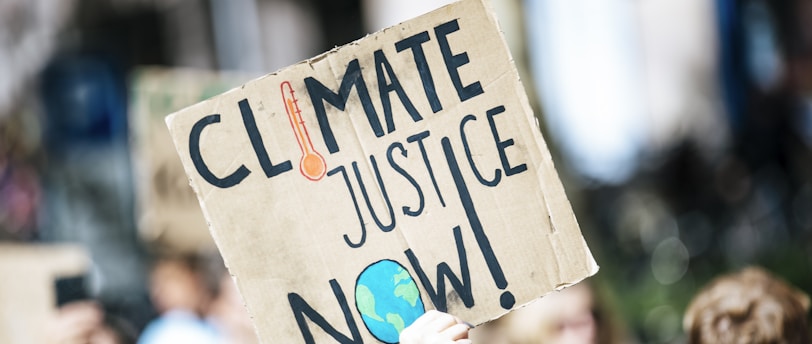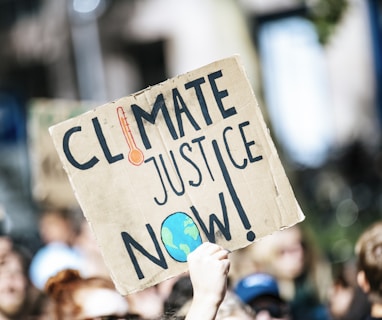Climate Justice: How we can all play a part
Climate justice is about ensuring that everyone is protected from the effects of climate change, regardless of their race, class, gender, or location. Here are some ways we can all play a part.
9/6/20234 min read


Introduction
Climate change is a global problem that is already having a devastating impact on people and the planet. The poorest and most vulnerable people are disproportionately affected by climate change, as they often live in areas that are most at risk from extreme weather events, such as floods, droughts, and heat waves.
Climate justice is about ensuring that everyone is protected from the effects of climate change, regardless of their race, class, gender, or location. It is about ensuring that the burden of climate change is not borne by the poorest and most vulnerable people.
What is Climate Justice?
Climate justice is a concept that recognizes that climate change is a social, economic, and environmental issue that disproportionately affects the most vulnerable people. It is about ensuring that everyone has the right to a safe, healthy, and sustainable environment.
Climate justice is based on the principles of equity, fairness, and sustainability. It calls for a just transition to a low-carbon economy that protects the rights of all people, especially the most vulnerable.
The Need for a Just Transition
The transition to a low-carbon economy is essential to address climate change. However, this transition must be just and equitable. It must not leave anyone behind.
A just transition means that everyone has the opportunity to benefit from the transition to a low-carbon economy. It means that workers in fossil fuel industries are supported through retraining and other measures so that they can find new jobs in the clean energy sector. It also means that communities that are disproportionately affected by climate change are supported through investments in infrastructure and other measures.
How Can We Achieve Climate Justice?
There are many things that we can do to achieve climate justice. Here are a few ideas:
Support policies that promote a just transition to a low-carbon economy. This could include policies that support renewable energy, energy efficiency, and sustainable agriculture.
Invest in renewable energy and energy efficiency. This will help to reduce our reliance on fossil fuels and create jobs in the clean energy sector.
Reduce our consumption of fossil fuels. We can do this by driving less, using public transportation, and walking or biking more. We can also choose to eat less meat, which is a major source of greenhouse gas emissions.
Support sustainable agriculture and food systems. This means eating locally grown food and reducing food waste.
Protect forests and other natural ecosystems. Forests absorb carbon dioxide from the atmosphere, so it is important to protect them.
Advocate for policies that protect the rights of the most vulnerable people. This could include policies that provide climate adaptation assistance to communities that are disproportionately affected by climate change.
By taking these actions, we can help to create a more just and sustainable future for everyone.
Here are some stats and data from India and around the world regarding climate justice:
India
India is the world's third-largest emitter of greenhouse gases.
The poorest and most marginalized communities in India are disproportionately affected by climate change.
For example, women and children are more likely to be exposed to the effects of heat waves and other extreme weather events.
Climate change is also disrupting agricultural production, which is a major source of income for many people in India.
Worldwide
The poorest and most marginalized people around the world are disproportionately affected by climate change.
This is because they are more likely to live in areas that are vulnerable to climate change, such as coastal areas and low-lying areas.
They are also more likely to have less access to resources, such as food, water, and shelter, which makes them more vulnerable to the effects of climate change.
Some specific examples of how climate change is impacting vulnerable communities around the world include:
In Bangladesh, climate change is causing more frequent and severe floods, which are displacing millions of people and destroying homes and businesses.
In Mali, climate change is causing droughts that are leading to food shortages and conflicts over scarce resources.
In the Arctic, climate change is melting sea ice, which is threatening the livelihoods of indigenous communities who rely on hunting and fishing.
What can be done to address climate justice?
There are a number of things that can be done to address climate justice. These include:
Investing in renewable energy and energy efficiency. This will help to reduce our reliance on fossil fuels, which are a major source of greenhouse gas emissions.
Supporting sustainable agriculture and food systems. This will help to reduce food insecurity and improve the livelihoods of farmers.
Protecting forests and other natural ecosystems. Forests absorb carbon dioxide from the atmosphere, so it is important to protect them.
Providing climate adaptation assistance to vulnerable communities. This could include providing financial assistance, infrastructure, and training to help communities cope with the effects of climate change.
By taking these actions, we can help to create a more just and sustainable future for everyone.
Green Goods Guide
In addition to taking these steps to promote climate justice, we can also make changes in our own lives to live more sustainably. Here are a few tips:
Choose sustainable products. When you're shopping, look for products that are made from recycled materials or that are produced in an environmentally friendly way.
Eat less meat. Meat production is a major source of greenhouse gas emissions. By eating less meat, we can reduce our impact on the climate.
Drive less. Driving is a major source of emissions. If you can, walk, bike, or take public transportation instead of driving.
Conserve water. Water is a precious resource, and we need to use it wisely. Take shorter showers, fix leaky faucets, and water your lawn less often.
Reduce, reuse, and recycle. When you reduce the amount of stuff you buy, you also reduce the amount of waste you produce. Reuse items whenever possible, and recycle everything else.
By making these changes, we can all help to promote climate justice and create a more sustainable future for our planet.
Related SEO Keywords:
climate justice
just transition
climate change
sustainability
equity
fairness
social justice
environmental justice
sustainable living
green goods
climate activism
climate advocacy
We hope this blog post has been helpful. Thank you for reading!
